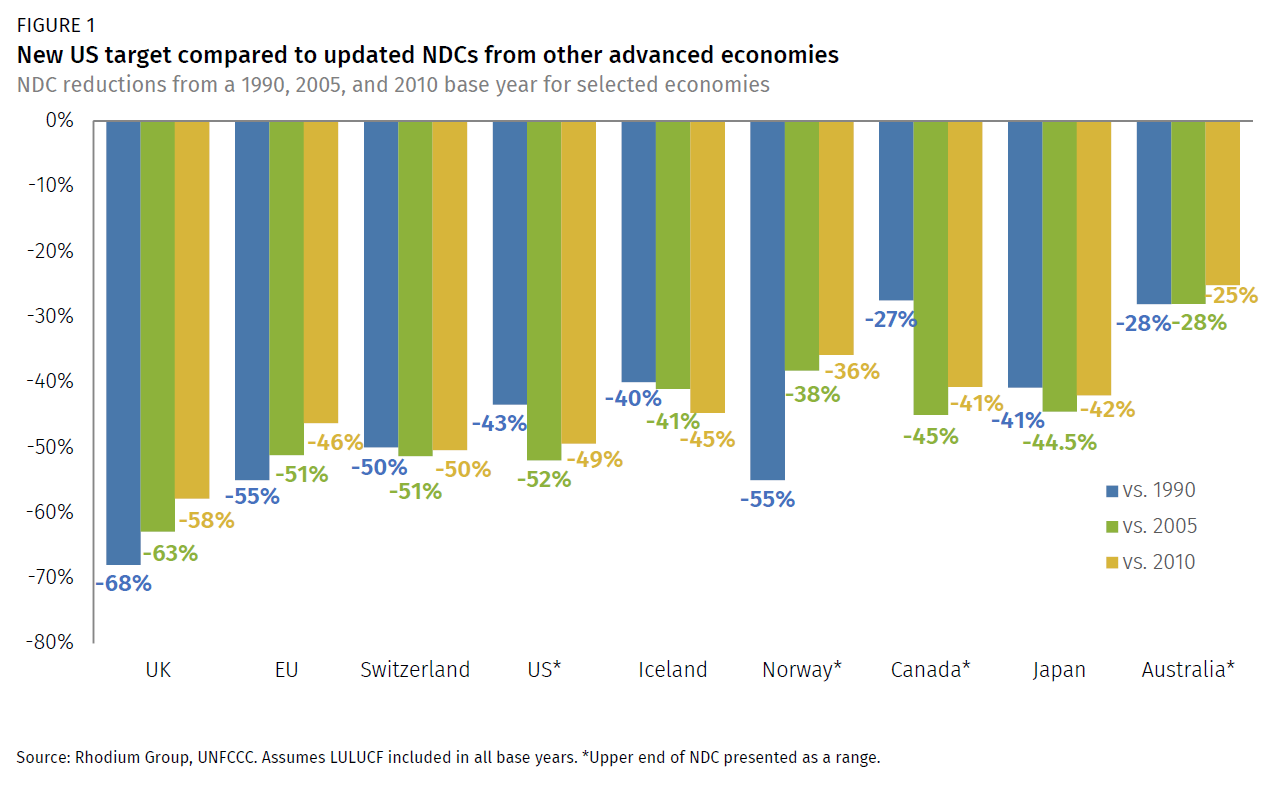Raising Climate Ambition: How a 50-52% US NDC Compares with Other Advanced Economies
How would a potential 50% US NDC stack up with commitments announced by other advanced economies?
On April 22, the Biden administration announced an updated US nationally-determined contribution (NDC) under the Paris Agreement, establishing US greenhouse gas emission reductions over the next decade and setting the course for a net-zero economy by 2050. As host to the Earth Day Leaders Summit, the US is using this announcement to leverage further ambition by the world’s major economies, with the aim of limiting warming to 1.5° Celsius. Civil society groups and a coalition of hundreds of governors and mayors had been calling on the Biden administration to adopt a 1.5°C-consistent NDC of reducing emissions by at least 50% below 2005 levels by 2030. Ultimately, the Biden administration announced an NDC of 50-52% below 2005 levels by 2030. In this note, we assess how the new US NDC stacks up compared to commitments announced to date by other advanced economies.
Assessing the comparability of countries’ NDCs is complicated by the fact that not all reductions are calculated from the same base year. One of the selling points of the Paris Agreement was the flexibility it provided countries to set their own nationally-determined targets, including the selection of a base year. Below we compare a potential US NDC of 50-52% below 2005 levels with those of other advanced economies, many of which use 1990 as their base year, to provide an apples-to-apples comparison (Figure 1).
When all NDCs are assessed against a 2005 baseline, a 50-52% US NDC puts the US among the top four most ambitious 2030 commitments when it comes to economy-wide emission reductions below historical levels. A 50-52% US NDC is still be far behind the UK at 63% below 2005 levels, but puts it on par with the EU, whose NDC of at least 55% below 1990 levels translates to around at least 51% below 2005 levels. It moves the US well beyond the 2nd tier of ambitious NDCs—like those from Canada, Japan, Iceland and Norway—which aim for reductions of around 40-45% below 2005 levels in 2030. A 50% US NDC also catapults it far beyond its current 2025 target of 26-28% below 2005 levels.
Translating current NDCs to a 2010 base year—as we do in Figure 1—also allows comparison to a benchmark set by the Intergovernmental Panel on Climate Change (IPCC) for global emission reductions consistent with limiting temperature rise to 1.5° Celsius. In its Special Report: Global Warming of 1.5°C (2018), the IPCC estimated that global CO2 emissions would need to decline at least 45% below 2010 levels to remain on track for 1.5°C. A 52% US NDC translates into 49% below 2010 levels.
Note: Rhodium Group originally published this note on April 14, 2021, and assessed a potential 50% US NDC. On April 22, 2021 we updated this note to reflect the official US announcement of a 50-52% NDC, as well as the April 22 announcement from Canada of an NDC of 40-45% below 2005 levels and the April 22 announcement from Japan of an NDC of 46% below 2013 levels.
